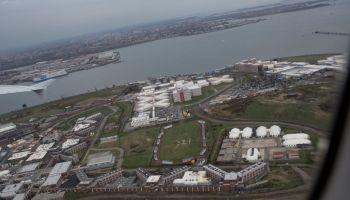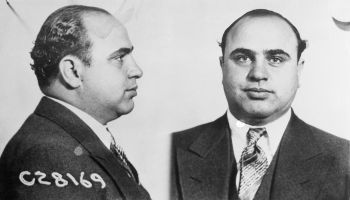VIA THE WASHINGTON POST:
President Obama lamented December job losses Friday while saying the overall employment trend “is still pointing in the right direction,” and he announced new tax credits aimed at spurring the growth of clean-energy jobs and promoting U.S. leadership in developing green technologies.
A government report that showed the nation shed 85,000 jobs in December, a worse-than-expected performance, serves as “a reminder that the road to recovery is never straight,” Obama told reporters at the White House. But he noted that job losses in the last quarter of 2009 were one-tenth of the total in the first quarter, and he credited last year’s $787 bill economic stimulus package with being “a major force in breaking the trajectory of this recession.”
Describing his green manufacturing initiative as one of the most popular elements of the stimulus package, Obama said building a “robust clean-energy sector” would help create the jobs of the future, reduce dependence on foreign oil and combat climate change. But he said the United States “is being outpaced” by other nations, including China, in developing the sector.
As part of an effort to “close the clean-energy gap,” he announced the awarding of $2.3 billion in tax credits to American manufacturers of technologies such as wind turbines, solar panels and cutting-edge batteries. The credits — destined for 180 projects in 40 states — will generate 17,000 jobs and help leverage $5 billion in private-sector investment that would create tens of thousands of additional jobs, while doubling the amount of renewable power over the next three years, Obama said.
Since there are far more qualified applicants for the credits than the federal funding will cover, he said, he is calling for investment of an additional $5 billion in the program.
Obama spoke hours after the Labor Department issued a report that suggests the economic recovery still is too weak to lead employers to add to their payrolls.
The unemployment rate was unchanged at 10 percent, the Labor Department said. Forecasters had expected zero net change in the number of jobs on U.S. payrolls, and some had had expected job growth to return. Those expectations were dashed by a report that — while not without bright spots — suggested that the long slog toward an improved labor market continued in December.
In a statement posted on the White House Web site, Christina Romer, one of President Obama’s top economic advisers, called the December job losses “a slight setback” but cautioned against reading too much into any one monthly report.
Results for November were revised upward from previous estimates, such that the Labor Department now says 4,000 jobs were created that month in contrast to initial estimates of a loss of 11,000 jobs. If the new number holds up through future revisions, November would be the first month of job growth since December 2007.
But the general theme from the December report was that signs of stability in the job market have not yet turned into overall job growth. According to a wide range of data, employers are not slashing jobs the way they were earlier in the year — the pace of new jobless claims has been declining steadily in recent weeks. But neither are employers adding to their payrolls or creating jobs at a pace anywhere near what would be needed to get the U.S. economy out of its deep hole of joblessness.
Part of the job losses might have been due to colder-than-usual weather; construction employment fell by 53,000 jobs, more than in recent months, and that sector is more sensitive than most to the weather.
One positive sign is that the number of temporary jobs rose by 47,000 jobs. Employers, it would seem, are reluctant to add permanent workers, but — faced with higher demand for their products — have little choice but to bring on temps. That could presage broader job creation in the future.
Less encouraging was the news that the average workweek for non-supervisory workers was unchanged at 33.2 hours. Employers cut back the hours of their employees dramatically through the deep economic downturn of the past two years and so far are restoring those hours at only a glacial pace.
Average hourly earnings were up slightly, however, 0.2 percent, to an average of $18.80 an hour.
The unemployment rate remained high, as many forecasters expect it to for many months. Not only did the nation continue to shed jobs, but the labor force shrank as 661,000 people pulled out of the workforce entirely, neither working nor seeking a job.
A broader measure of unemployment, which includes people who are working part time but would prefer a full-time job and those who have given up looking for work out of frustration, edged up to 17.3 percent, from 17.2 percent.
The latest employment report nevertheless is “consistent with the gradual labor market stabilization we have been seeing over the last several months,” Romer said.
“Compared with the unexpectedly good report for November, December’s job loss is a slight setback,” she said, adding that “the unemployment rate remains unacceptably high, which underscores the need for responsible actions to jump-start private-sector job creation.” Cautioning that “the road to recovery will not be a straight line,” she said monthly jobs numbers “are volatile and subject to substantial revision. Therefore, it is important not to read too much into any one monthly report, positive or negative.”
In an interview on MSNBC, Romer, who chairs Obama’s Council of Economic Advisers, said that compared to earlier last year, “we’re on an improving trajectory.” She pointed to growth in gross domestic product in the third quarter and said “an even stronger number” is expected for the fourth quarter.
Romer said that “job growth by spring . . . is still completely realistic.” However, “the important thing is we don’t just want positive job growth; we want big job growth, because that’s what’s going to put people back to work.”
- Libya: Entertainment, Food, Languages, Places To Visit + More
- Algeria: Entertainment, Food, Languages, Places To Visit + More
- Egypt: Entertainment, Food, Languages, Places To Visit + More
- South Sudan: Entertainment, Food, Languages, Places To Visit + More
- Morocco: Entertainment, Food, Languages, Places To Visit + More














